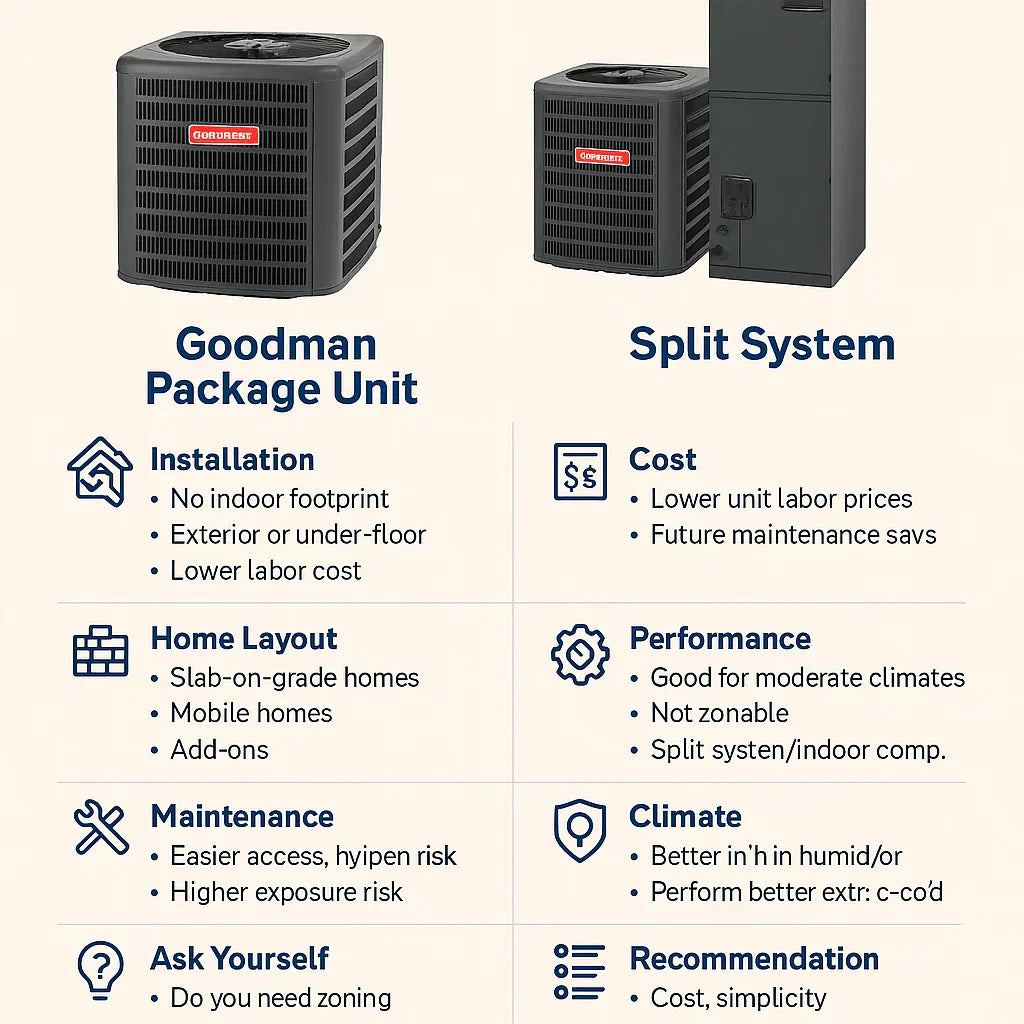If you're comparing HVAC options for your home, one of the first decisions you'll face is whether to choose a package unit or a split system. Both offer reliable comfort when installed properly, but they serve different home layouts, budgets, and climates.
This Savvy homeowner guide compares Goodman package units, like the 2.5 Ton 13.4 SEER2 Self-Contained Horizontal Package AC, to traditional Goodman split systems.
🛠️ What’s the Difference Between a Package Unit and a Split System?
Package System:
-
All-in-one unit with compressor, coil, and blower
-
Installed outside on the ground or roof
-
Connects to ducts via one cabinet
Split System:
-
Two-part system with:
-
Outdoor condenser unit
-
Indoor air handler or gas furnace
-
-
Linked by refrigerant lines
🔗 More on this from HVAC.com
🏡 Installation Differences: Space, Labor & Design
| Feature | Package System | Split System |
|---|---|---|
| Indoor Equipment | None | Furnace or air handler required |
| Ductwork Routing | Outside or crawlspace | Inside walls or attic |
| Labor Cost | ⬇ Lower | ⬆ Higher |
| Install Time | ⏱ Faster | ⏱ Slower |
Tip: Package units shine in homes with no attic or basement access.
💸 Cost Breakdown: Unit, Labor & Lifecycle
Upfront Cost:
-
Package units typically cost less to install (fewer parts, less time)
-
Split systems may cost more due to added indoor unit and refrigerant lines
Labor:
-
Package: ~$1,500–$2,500
-
Split: ~$2,500–$4,000 (depending on duct access)
Long-Term:
-
Split systems are easier to upgrade in stages
-
Package units may need full replacement when one component fails
🏚 What Home Layouts Suit Each System?
Best for Package Units:
-
Slab-on-grade homes
-
Manufactured/mobile homes
-
Additions, garages, or workshops
-
Homes with rooftop installation areas
Best for Split Systems:
-
Two-story or multi-zone homes
-
Ducts in attics or basements
-
Need for indoor air quality upgrades (humidifiers, filters)
⚙️ Efficiency & Performance: How They Stack Up
Goodman Package Units:
-
SEER2 range: 13.4–15.2
-
Available as AC-only, gas/electric, or heat pump combos
Goodman Split Systems:
-
SEER2 range: 14.3–20+
-
Compatible with multi-speed air handlers and modulating furnaces
| Feature | Package | Split |
| Max Efficiency | Moderate | High |
| Multi-Zone Capable | Limited | Yes |
| Smart Thermostat Compatible | Yes | Yes |
✨ ENERGY STAR certification often requires 15.2+ SEER2, available more commonly in split systems.
🧹 Maintenance, Access & Lifespan
| Consideration | Package Unit | Split System |
| Access | Outdoor-only | Indoor + Outdoor |
| Maintenance | Easier (all parts in 1 box) | Split duties across components |
| Element Exposure | High | Lower (indoor parts protected) |
| Expected Lifespan | 12–15 years | 15–20 years (indoor parts last longer) |
📅 Pro Tip: Have your unit serviced twice yearly regardless of system type.
🌇 Climate Considerations
Package Units:
-
Work well in temperate or dry climates
-
May struggle in extremely humid or cold zones
Split Systems:
-
Better suited for humid or cold areas (can include gas furnace)
-
Easier to upgrade components for high-efficiency or dehumidification
Example: Florida homes may benefit from a high-SEER2 split with enhanced humidity control.
🤔 Questions to Help You Decide
-
Do I have indoor space for an air handler or furnace?
-
Will I benefit from multi-zone cooling?
-
Is installation speed or cost more important?
-
Will my climate require high efficiency or special features?
-
Do I need a system that qualifies for rebates or tax credits?
🔗 Rebates Database: DSIREUSA.org
📊 Final Recommendation Checklist
Choose a Package Unit if:
-
✅ You want a faster install
-
✅ You have limited indoor space
-
✅ Your home has basic single-zone ductwork
-
✅ You live in a mild or dry climate
Choose a Split System if:
-
✅ You want zoning or smart thermostat control
-
✅ You plan to expand or upgrade in stages
-
✅ You live in a hot, humid, or cold climate
-
✅ You qualify for rebates or ENERGY STAR incentives
In the next topic we will read about: How to Maintain a Self-Contained Package Unit: Filters, Coils & Seasonal Checks







